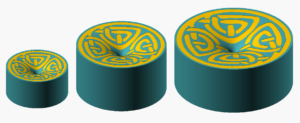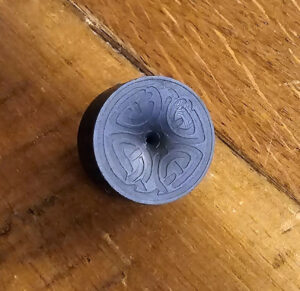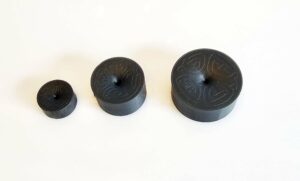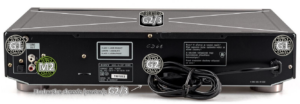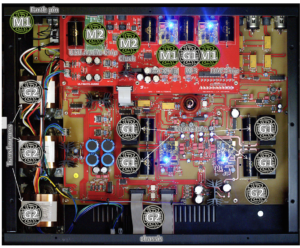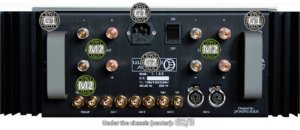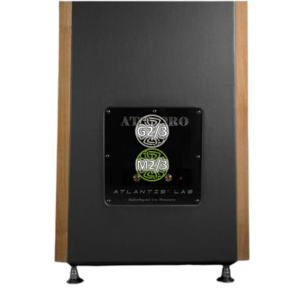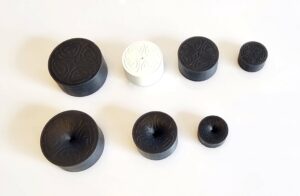MASKHÅL is an absorber resonator, to be placed within air-vibranting areas to protect microphonic-prone surfaces.
Concept
Maskhåls are designed with black-holes & worm-holes in mind. They absorb air vibrations and filter it through different mechanisms (traps, light & heavy & soft membranums) so that these stop polluting (being reinjected in) surrounding electronics (see Daedale feet for more explanations) or cables. As such, they participate in our vibrations countering quest to unveil the true potential of your hifi system.
This may sound weird, but these tiny resonators are true wonders. We already produced some hundred of these for friends & partners, and they are the ones who brought us to the idea of proposing them to a wider audience.
Design
Please note that our labyrinth grooves on the wormhole-face are also there for sonic purpose. Smooth surfaces can be appreciated as neat, but are less effective in guiding air/vibrations. They lack some grip, and there is a small lazy air layer right next to flat surfaces. This reduce the system effectiveness, here our cone opening. But this is true as well for bass-reflex speakers flow-ports of some hi-fi manufacturers, who use some grainy or hex-textured surfaces for more grasping… hence flow. A smooth 10cm diameter flow-port is considered to be like a 9cm effective diameter. Some highend loudspeakers external surfaces also show this kind of flow-helping feature. Even aircraft manufacturers work on the laminar effect of their wings on a similar manner. Or to be even simpler… imagine a golf-ball without these tiny grooves. It would be less directive, would only reach shorter distances because of a less floating ability… Ok. You got it !
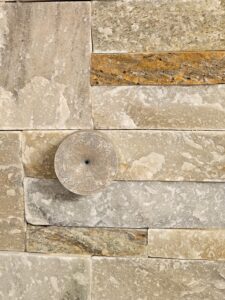
Usage
Simply place Maskhål pieces on the place to protect with some blue-tac (patafix…) square and that’s it. You can try other locations. We will provide exhaustive advices soon. Please note that blue-tac blocks are provided with each Maskhål.
In traditional setup, we advise far more Maskhåls than Geysírs. This is easy to explain, as air-vibrations are everywhere to counter, while mechanical vibrations can be effectively refrained by placing only a couple of Geysírs on properly chosen places.
You can also place Maskhåls (preferably III for wider effect) on your walls / bricks… at ears height. Annoying vortexes get birth there behind the speakers and in the corners, giving a touch of high-mediums harshness / “white color” focus on the low trebles. Placing Maskhåls there calms immediately the thing down, the soundstage gets peacefully wider and high-meds even gets some more realistic body.
Maskhåls are highly effective placed on circuitry and even chips, clocks and DAC chips.
On demand, Maskhåls can be customized with a specific colour to accomodate your needs. Default colour is black.
More info on Geysír
Known working places:
- plugs, chassis next to plugs, chips on circuitry…
- Wall behind speakers
- See variations section below
- more options will come with customers feedbacks – and will be inserted here
Variations
Maskhål are proposed in 3 variations. These can be mixed together. Along with Geysírs. See dedicated section below.
You optionnaly can place your Maskhål on a Draupnir Cable Ring for additional convenience & stability.
Maskhål I, small one
Easy to place, immediate effect
- Diameter : 20mm
- Height: 11mm
Place on :
- plugs on both side of the cables (RCA, XLR, Spades, Bananas, RJ45, HDMI…)
- on the chassis just next to the plug
- on your circuitry board – directly on the chips to protect (use heat conductive tapes)
- Bifröst rooftop
Maskhål II, standard one
Richer damping features inside that little one.
Requires a little more room to place
- Diameter : 32mm
- Height: 18mm
Place on :
- on chassis wide areas, for instance between RCAs or bananas
- on your speaker plate, between bindposts
- on your circuitry board highly sensitive CLOCK, or chips (use heat conductive tape)
- Cable splitters
- Bifröst rooftop
Maskhål III, the big one
Same comment as II, on a further step
- Diameter : 42mm
- Height: 20mm
Place on :
- As II where possible
- Walls behind speakers at ear height
- Room corners at hear height
Setup pictures below are provided as a plain illustration of the textual guidelines provided above. This does not mean you need all resonators for proper performance. You can put less. You can put more. You can even put none. It’s all about experimentation & a fun path to improve sonic abilities of your existing devices. Remembers resonators are movable thankt to their bluetac/patafix patch. It’s all yours !
Maskhål or Geysír?
These can be seen as similar in their shape and in the fact that they are to counter vibrations. They can also be placed together depending on required usage.
But as a matter of clarification, consider that :
-
- Maskhål absorbs air-borne vibrations to protect what is behind it
-
- Geysír asborbs ground/mechanical vibrations and spits it in a translated/inoffensive frequency to protect what is all around
In this way, their function is opposite. But like in many things, this is not so black or white. We can consider that thanks to their relative construction similarity, Geysír act like a 30% Maskhål, and vice versa. So no worries in mixing them.
In traditional setup, we advise far more Maskhåls than Geysírs. This is easy to explain, as air-vibrations are everywhere to counter, while mechanical vibrations can be effectively refrained by placing only a couple of Geysírs on properly chosen places.
More info on Geysír
Etymology
Maskhål is the swedish name for a worm-hole (astrophysics), which is a shortcut to another dimension. Blackholes have such a gravity that they “swallow” everything around.
Storage precaution
Because of their Nordic origin, Maskhåls and Geysírs need to be maintained at -20°c between listening sessions. Okay… stupid joke. This is a passive system. Simply place and enjoy !


